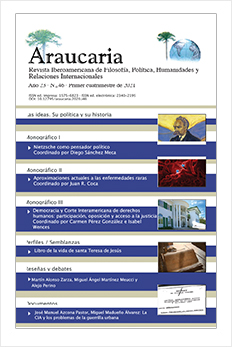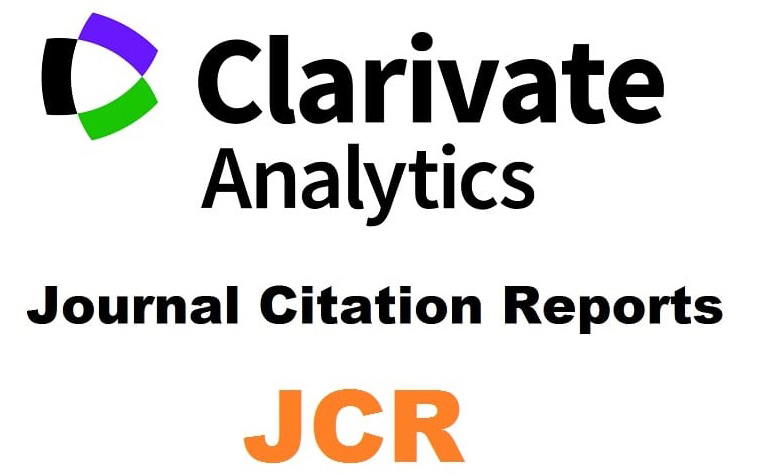Condicionantes biosociales de las enfermedades no diagnosticadas
DOI:
https://doi.org/10.12795/araucaria.2021.i46.18Parole chiave:
Normalidad, estructura social, normalidad, diversidad, biosemióticaAbstract
En este trabajo de investigación nos aproximamos al conocimiento de las enfermedades no diagnosticadas. Dichas enfermedades se enmarcan dentro de las llamadas enfermedades raras, debido a que no son frecuentes. Generan una serie de condicionantes en la vida de las personas afectadas y en sus relaciones sociales. Ello es fruto de la ruptura semiótica entre el código biológico y el social. Esta situación puede obligar a las personas con estas enfermedades a estar situadas fuera de la estructura social y ver reducido su capacidad para tomar decisiones. Por esta razón es necesario desarrollar puentes semióticos que conecten los códigos de los que hemos hablado.
Downloads
Riferimenti bibliografici
Archer, M.S. (2009). Being Human: The Problem of Agency. Cambridge: Cambridge University Press.
Archer, M.S. (2010). Routine, Reflexivity, and Realism. Sociological Theory 28(3), 272-303. https://doi.org/10.1111/j.1467-9558.2010.01375.x
Archer, M.S. (2016). “Anormative Social Regulation: The Attempt to Cope with Social Morphogenesis”. In: M.S. Archer (eds.) Morphogenesis and the Crisis of Normativity. Switzerland, Springer-Nature, pp. 141-168.
Augé, M. (1996). El sentido de los otros. Actualidad de la antropología. Barcelona: Paidós.
Balandier, G. (2014). El desorden. La teoría del caos y las ciencias sociales. Barcelona: GEDISA.
Barbieri, M. (2015). Code Biology. A New Science of Life. Dordrecht: Springer.
Barbieri, M. (2019). Code Biology, Peircean Biosemiotics, and Rosen’s Relational Biology. Biological Theory 14, 21-29.
Baudelaire, Ch. (2004). El pintor de la vida moderna. Murcia: Colegio Oficial de Aparejadores y arquitectos Técnicos, Consejería de Educación y Cultura y Fundación CAJAMURCIA.
Bauman, Z. (2003). Modernidad líquida. México: Fondo de Cultura Económica.
Bauman, Z. (2004). La sociedad sitiada. Buenos Aires: F.C.E.
Baumer, F. L. (1985). El pensamiento europeo moderno. Continuidad y cambio en las ideas, 1600-1959. México: F.C.E.
Bellah, R. (2017). La religión en la evolución humana. Del Paleolítico a la era axial. Madrid: CIS.
Berman, J.J. (2015). Enfermedades raras y medicamentos huérfanos. Claves para entender y tratar las enfermedades comunes. Barcelona, Elsevier.
Berry, E. (2011). The role of the sociotype in managing chronic disease: Integrating bio-psycho-sociology with systems biology. Medical Hypotheses 77(4), 610–613.
Boudon, R. (1982). The Unintended Consequences of Social Action. London, Macmillan Press.
Coca, J.R. (2017). La Socio-hermenéutica Multidimensional como Teoría Social basada en los Imaginarios, la Irrealidad y la Utopía, Utopía y praxis latinoamericana 22 (76), 41-55.
Coca, J.R. (2019a). “Patologías de baja prevalencia en contexto social: Análisis teórico introductorio”. In: Coca, J.R. (eds.) Enfermedades raras. Contribuciones a la investigación social y biomédica. Soria, Ceasga-Publishing.
Coca, J.R. (2019b). (eds.) Enfermedades raras. Contribuciones a la investigación social y biomédica. Soria, Ceasga-Publishing.
Coca, J.R., Rivas-Torres, A. y Cordero, A. (2020). Bases biológicas de la socialidad. Nova Acta Científica Compostelana (Bioloxía) 27: 51-58.
Coca, J.R., Sanz-Molina, L, Eraña, H. y Castilla, J. (2019). Análisis cualitativo del impacto social y familiar de las encefalopatías espongiformes transmisibles humanas. Revista de Neurología 69(6), 242-249. https://doi.org/10.33588/rn.6906.2019122
Conrad, P. y Barker, K.K. (2010). The Social Construction of Illness. Key Insights and Policy Implications. Journal of Health and Social Behavior 51(S): S67-S79. https://doi.org/10.1177/0022146510383495
Elias, N. (2000). Teoría del símbolo. Un ensayo de antropología cultural. Barcelona: Península.
Endress, M. (2014). “Interpretive Sociologies and Traditions of Hermeneutics”. In: Staudigl M., Berguno G. (eds) Schutzian Phenomenology and Hermeneutic Traditions. Contributions to Phenomenology, vol 68. Springer, Dordrecht. 33-54. https://doi.org/10.1007/978-94-007-6034-9_3
Farson, R.E. (1973). Las potencialidades humanas, en VVAA, Ensayos sobre el Apocalipsis. Barcelona: Kairós.
Flyvbjerg, B. (2001). Making Social Science Matter. Why social inquiry fails and how it can succeed again. Cambridge: Cambridge University Press.
Gadamer, H.G. (1984). Verdad y método. Fundamentos de una hermenéutica filosófica. Salamanca: Sígueme.
Gainotti, S., Mascalzoni, D., Bros-Facer, V., Petrini, C., Floridia, G., Roos, M., Salvatore, M. y Taruscio, D. (2018). “Meeting Patients’ Right to the Correct Diagnosis: Ongoing International Initiatives on Undiagnosed Rare Diseases and Ethical and Social Issues”. International Journal of Environmental Research and Public Health 15, 2072. https://doi.org/10.3390/ijerph15102072
Gaspar, S. (2003). Consecuencias no intencionales y figuración: una incursión crítica en la obra de Norbert Elias. Reis, 119-148.
Giddens, A. (2013). The Constitution of Society: Outline of the Theory of Structuration. New York: John Wiley & Sons.
Ginev, D. (2016). Hermeneutic Realism. Reality Within Scientific Inquiry. Switzerland: Springer-Nature.
Goffman, E. (2009). La presentación de la persona en la vida cotidiana. Buenos Aires: Amorrortu.
González, J.M. (2006). La diosa Fortuna. Metamorfosis de una metáfora política. Madrid: Antonio Machado libros.
Grondin, J. (2003). Introducción a Gadamer. Barcelona: Herder.
Heidegger, M. (1971). El ser y el tiempo. México: Fondo de Cultura Económica.
Hopcroft, R.L. (2016). Grand Challenges in Evolutionary Sociology and Biosociology. Frontiers in Sociology 1, article 2. https://doi.org/10.3389/fsoc.2016.00002
Jaspers, K. (2017). Origen y meta de la historia. Barcelona: Acantilado.
Koselleck, R. (2016). historia/Historia. Madrid: Trotta.
Kuper, H., Banks, L. M., Bright, T., Davey, C., y Shakespeare, T. (2020). Disability-inclusive COVID-19 response: What it is, why it is important and what we can learn from the United Kingdom's response. Wellcome open research, 5, 79.
Lamo de Espinosa, E. (1990). La sociedad reflexiva. Madrid: Siglo XXI.
Lizcano E. (2003). “Imaginario colectivo y análisis metafórico”, transcripción de la conferencia inaugural del Primer Congreso Internacional de Estudios sobre Imaginario y Horizontes Culturales que se celebró en la Universidad Autónoma del Estado de Morelos, Cuernavaca, México, del 6 al 9 de mayo. http://www.unavarra.es/puresoc/pdfs/c_salaconfe/SC-Lizcano-2.pdf
Luhmann, N. y De Giorgi (1993). Teoría de la sociedad. México: Universidad de Guadalajara / Universidad Iberoamericana.
Luhmann, N. (1996a). “La contingencia como atributo de la sociedad moderna”, en Las consecuencias perversas de la modernidad: modernidad, contingencia y riesgo. Barcelona: Anthropos.
Luhmann, N. (1996b). Confianza. Barcelona: Anthropos.
Maffesoli, M. (2020). “De L´Universalisme à l´uni-diversité postmoderne”, en Celso Sánchez-Capdequí y Juan A. Roche Cárcel, Modernidades regresivas. Madrid: CIS (en prensa).
Marijuán P.C., Montero-Marín, J., Navarro, J., García-Campayo, J. y del Moral, R. (2017). The “sociotype” construct: Gauging the structure and dynamics of human sociality. PLOS ONE 12(12), e0189568. https://doi.org/10.1371/journal.pone.0189568
Merton, R. (1936). The Unanticipated Consequences of Purposive Social Action. American Sociological Review, 1(6), 894-904.
Moulines, C.U. (2011). El desarrollo moderno de la filosofía de la ciencia (1890-2000). México: UNAM/IIF.
Nair, S., De Jucas, J. (1999). Inmigrantes. El desplazamiento en el mundo. Madrid: Ministerio de Trabajo y Asuntos Sociales. Secretaría General de Asuntos Sociales. Instituto de Migraciones y Servicios Sociales.
Nescolarde-Selva, J.A., Gash, H. y Usó-Domenech, J.L. (2019). What are unintended and adverse consequences?, Kybernetes 48(2), 226-237. https://doi.org/10.1108/K-12-2017-0466
Ortega, M., Gómez-Chaparro, J.L., González-Meneses, A., Guillén, J., Varo, A. y Fernández, E. (2012). Mapas conceptuales para el diagnóstico de enfermedades raras en atención primaria. Atención primaria 44(1), 43-50. https://dx.doi.org/10.1016%2Fj.aprim.2011.01.009
Palau, F. (2020). Enfermedades raras. Ciencia y realidad de la rareza en medicina. Madrid: Los libros de la catarata.
Picó, J. (1988). “Introducción”, Modernidad y Posmodernidad. Madrid: Alianza.
Ramos, R. (1993). “Una aproximación a las paradojas de la acción social”. Problemas de teoría social contemporánea. Madrid: CIS.
Reed, I.A. (2011). Interpretation and Social Knowledge. On the Use of Theory in the Human Sciences. Chicago: The University of Chicago Press.
Reichertz, J. (1988). Verstehende Soziologie ohne Subjekt? Die objektive Hermeneutik als Metaphysik der Strukturen. Kölner Zeitschrift für Soziologie und Sozialpsychologie 40, 207–222.
Ricoeur, P. (1988). Hermenéutica y Acción. De la Hermenéutica del Texto a la Hermenéutica de la Acción. Buenos Aires: Prometeo Libros-UCA.
Ricoeur, P. (1996). Sí mismo como otro. España: Siglo XXI.
Roche, J.A. (2009). La sociedad evanescente. Barcelona: Anthropos.
Sabatello, M., Blankmeyer, T., McDonald, K.E. y Appelbaum, P.S. (2020). Disability, Ethics, and Health Care in the COVID-19 Pandemic. American Journal of Public Health 110, 1523-1527.
Sánchez Capdequí, C. (2004). Las máscaras del dinero. El simbolismo social de la riqueza. Barcelona: Anthropos-Universidad Autónoma Metropolitana.
Sartori, Giovanni (2003). La sociedad multiétnica. Pluralismo, multiculturalismo, extranjeros e islámicos. Madrid: Taurus.
Schutz, A. (1967). The phenomenology of the social world. Evanston, Northwestern University Press.
Sontag, S. (1996). La enfermedad y sus metáforas y El sida y sus metáforas. Madrid: Taurus.
Sulik, G. (2009). Managing Biomedical Uncertainty: The Technoscientific Illness Identity. Sociology of Health & Illness 31(7), 1059-76. DOI: https://doi.org/10.1111/j.1467-9566.2009.01183.x
Sulik, G.A. (2011). ‘Our Diagnoses, Our Selves’: The Rise of the Technoscientific Illness Identity. Sociology Compass 5 (6), 463-477. DOI: https://doi.org/10.1111/j.1751-9020.2011.00374.x
Taruscio, D., Groft, S. C., Cederroth, H., Melegh, B., Lasko, P., Kosaki, K., Baynam, G., McCray, A. y Gahl, W.A. (2015). Undiagnosed Diseases Network International (UDNI): White paper for global actions to meet patient needs. Molecular genetics and metabolism, 116(4), 223-225. https://doi.org/10.1016/j.ymgme.2015.11.003
Thiebaut, C. (1996). “La mal llamada postmodernidad (o las contradanzas de lo moderno)”, en Valeriano Bozal, Historia de las ideas estéticas y de las teorías artísticas contemporáneas, Vol. II. Madrid: Visor.
Tifft, C.J. y Adams, D.R. (2014). The National Institutes of Health undiagnosed diseases program. Current Opinion in Pediatrics 26(6), 626-633.
Tuomela, R. (2010). The Philosophy of Sociality. The Shared Point of View. Oxford: Oxford University Press.
Tuomela, R. (2013). Social Ontology. Collective Intentionality and Group Agents. Oxford: Oxford University Press.
Veblen, Th. (2008). Teoría de la clase ociosa. Madrid: Alianza.
Ward, L.F. (1905). Evolution of social structures. American Journal of Sociology 10(5), 589-605.
Ward, L.F. (1921). Pure sociology. On the origin and spontaneous development of society. London: Macmillan Company.
Wehling, P. (2011). The “technoscientization” of medicine and its limits: technoscientific identities, biosocialities, and rare disease patient organizations. Poiesis & Praxis 8 (2-3), 67-82. DOI: http://doi.org/10.1007/s10202-011-0100-3
Wittgenstein, L (2009). Wittgenstein I. Madrid: Gredos.
Zubiri, X. (1998). Sobre el hombre. Madrid: Alianza.
##submission.downloads##
Pubblicato
Come citare
Fascicolo
Sezione
Licenza
Las ediciones impresa y electrónica de esta Revista son editadas por el Secretariado de Publicaciones de la Universidad de Sevilla, siendo necesario citar la procedencia en cualquier reproducción parcial o total.Salvo indicación contraria, todos los contenidos de la edición electrónica se distribuyen bajo una licencia de uso y distribución “Creative Commons Atribución-NoComercial-SinDerivar 4.0 Internacional”








